A few months ago, I told my Manchester United supporting roommate that I'd want Liverpool to sign Aaron Wan-Bissaka if it were not for the fact that we already had Trent Alexander-Arnold.
I hadn't based this opinion on anything other than the fact that I was pretty impressed with what I was seeing whenever I had the chance to watch him play.
Nevertheless, I knew that Alexander-Arnold was up there with some of the best in the world at just 20 years of age, so didn't give it any more thought.
Manchester United have since signed Wan-Bissaka and I must admit that it made me slightly worried. Over the last few days, Twitter has been flooded with tweets from elated Manchester United supporters sharing statistics that they claim prove that Wan-Bissaka is a better right-back than Alexander Arnold.
Now, I wasn't stupid enough to get sucked into this. I knew that Alexander-Arnold was the more accomplished right back, but I did start to wonder how far apart they were at this stage in their careers.
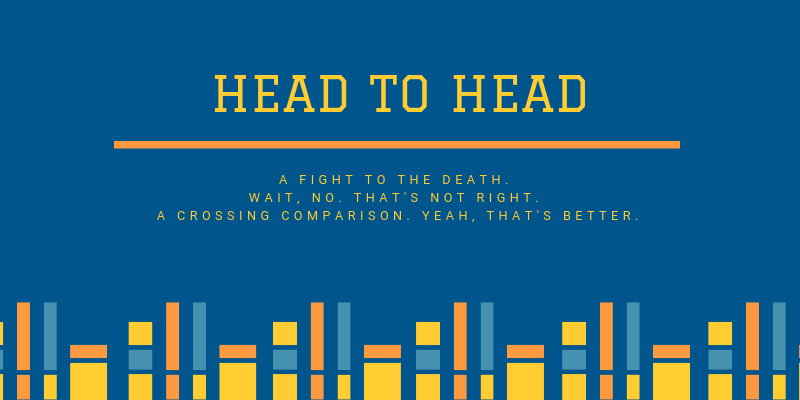
The issue with statistics is that they can often be skewed to show the outcome you'd hoped for. For example, former Liverpool defender Ragnar Klavan had just 1 shot in the entire 2017/18 season and scored from it. Statistically, therefore, Klavan had a 100% shot on target rate and a 100% conversion rate. Yet, even the most biased of stat users wouldn't think of him as anything other than a mediocre defender. The small amount of data skews reality.
Enter Twitter user @utdarena, who posted a Tweet comparing the crossing accuracy of right-backs around the world:
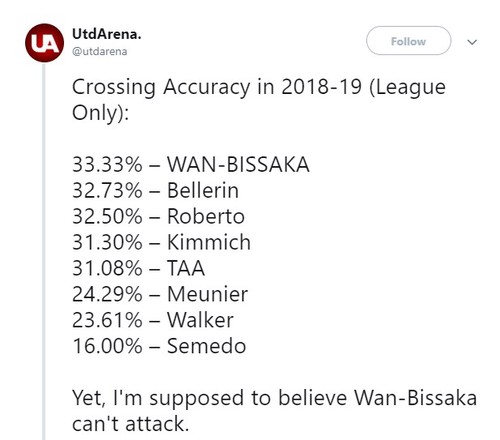
At first glance, you might think that Wan-Bissaka is perhaps the best crosser of a ball in world football. Of course, plenty of Manchester United fans ran with this narrative, although I should point out that not all of them were so quick to jump to that conclusion.
The issue with this tweet, in particular, is that is doesn't provide any data other than some ambiguous raw figures.
What else is taken into account?
- How many minutes did each player complete?
- How many crosses did each player make?
- What kind of crosses were made?
- Who was on the receiving end of the cross?
There are plenty of reasons for this data to be scrutinised, and that's exactly what Twitter user @CraqueStats did, creating one of the most interesting football twitter threads I've read in a long time.
For the rest of this post, I will be referring to stats and images provided by @CraqueStats and providing some extra comments to add my own opinion.
Let's first start with some of the most obvious issues with the crossing accuracy stats provided by @utdarena.
What is an accurate cross?
When looking at crossing statistics, you need to understand what is recorded as an accurate cross by data collectors.
For most of us, we'll imagine an accurate cross being a ball that is crossed in from outside the penalty box that successfully finds its intended target. Yet, while that is indeed an accurate cross, there are sketchier versions of events that also meet the criteria.
For example, if a player swings in a cross that gently grazes a teammate's big afro hairstyle and goes wildly out for a throw-in, that's also considered an accurate cross. This is where things get a bit tricky because there is an obvious difference between this example and a perfectly timed cross that a player heads into the goal with ease.
Cutting out the bullshit
What @CraqueStats went on to do was to try to find a more accurate way to compare players in this department by cutting out as much nonsense as possible.
The first thing he did was make use of Opta data, a well known accurate source of statistics.
He then decided to cut down the list of players who were compared by only looking at Premier League players. This is because data can be tracked slightly differently from league to league.
On top of this, he cut out most of the players who skew the figures (think back to the Klavan example) by only looking at players who completed at least 10 crosses and played a minimum of 1000 minutes throughout the season.
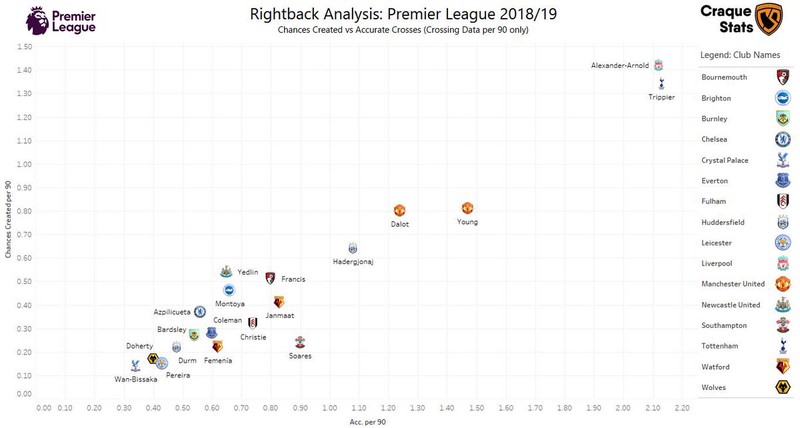
This first comparison made was the number of crosses completed in an average game and how many chances are created from those crosses.
The staggering thing for me here is just how ahead of everyone else Alexander-Arnold and Trippier are. Both players are putting in an average of over 2.1 crosses per game but also creating around 1.3 and 1.4 chances respectively.
What you'll also notice here is that Wan-Bissaka is the worst of the bunch in this regard, completing just over 0.3 crosses per game and creating just over 0.1 chances per game from those crosses.
Now, some people may argue that this is because Wan-Bissaka is playing for Crystal Palace but that doesn't really make much sense because he's performing at a lower level than every other player in the list, including those playing for relegated teams.
All this data really shows us is that Wan-Bissaka doesn't cross the ball very much whereas Alexander-Arnold and Trippier do.
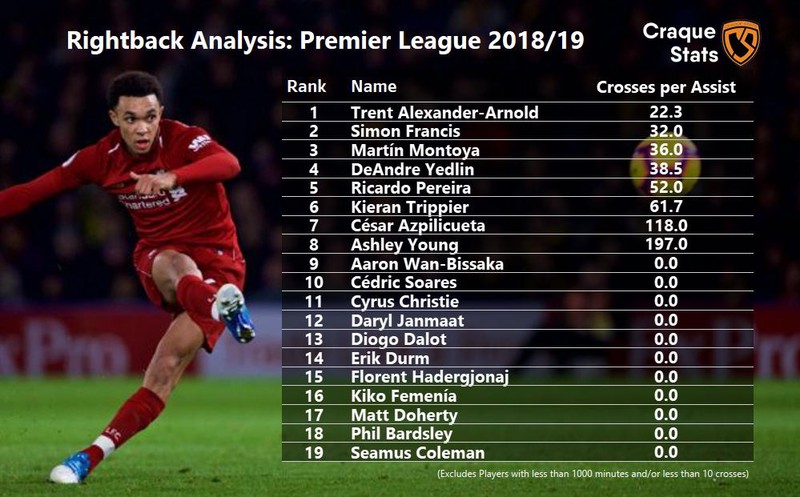
@CraqueStats then moved on to the effectiveness of crosses for each player. The image above shows how many crosses each player made per assisted goal. Once again, Alexander-Arnold tops the list with 22.3 crosses made per assisted goal.
You'll notice that some players have a score of 0.0 and this is because, no matter how many crosses they made in the season, they did not assist a single goal in the process.
Wan-Bissaka is again looking pretty poor in this regard as his team did not score a goal from any of his crosses but we do have to consider other players when looking at this statistic.
Alexander-Arnold, for example, is crossing into 3 top-class forwards in Mane, Salah, and Firmino. Other players on the list do not have this advantage so we can't take too much from this other than the fact that Alexander-Arnold's crossing certainly is effective within the Liverpool team.
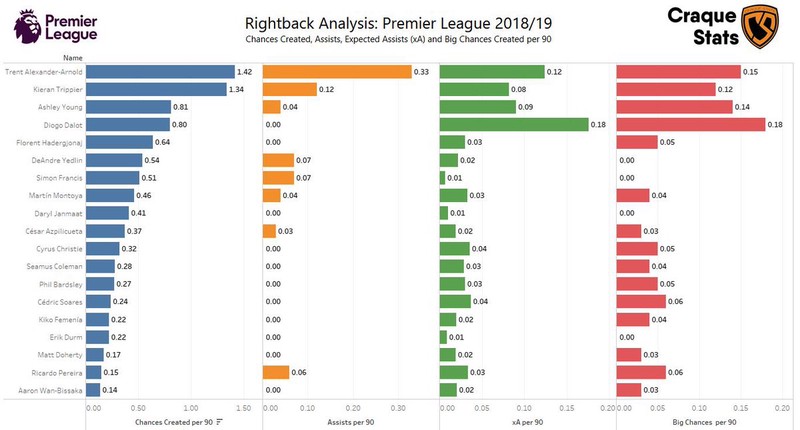
Moving on, the above image is perhaps the one I found most interesting. It shows how chances each player is creating on average per 90 minutes from crosses (blue), how many assists (orange), how many expected assists from their crosses (green), and how many big chances created (red).
What we can see, once again, is that Alexander-Arnold is topping the list in almost every way. His statistics are certainly elite in this regard. Trippier is also performing at a very high level for Tottenham.
Sadly for Manchester United supporters, Wan-Bissaka is once again at the bottom of the list in these metrics. Again, the argument of him playing for a lesser club doesn't hold much weight because he's in there with players of similar strength teams.
Now, I realise that you can't just take one set of data and make big claims as to who is the better defender. Alexander-Arnold is clearly up there with the best when it comes to crossing accuracy and how much Liverpool actually benefit from those crosses.
Wan-Bissaka is perhaps one of the worst in the Premier League in this regard. However, that isn't to say that he won't be a great addition for Manchester United. I haven't looked at the data, but he certainly appears to be a talented defender, if not of the attacking variety.
Nevertheless, this is perhaps a lesson that we shouldn't take things at face value or base a player's worth on single statistics alone.
For now, I'll back Alexander-Arnold as the better player. He's a 20-year-old European Champion and did a lot to help Liverpool gain that title. I look forward to seeing how Wan-Bissaka gets on, however, and I think he'll be a good addition to the Manchester United team who have needed to strengthen in that area for some time.
Comments